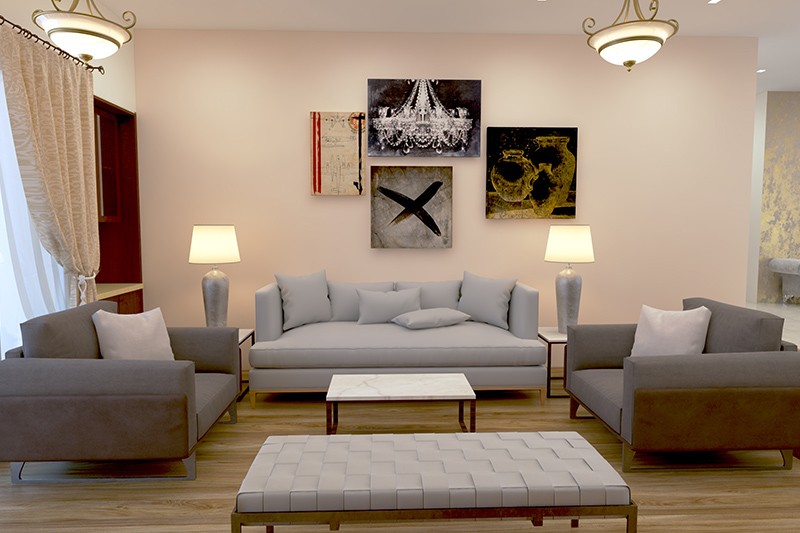The Impact of Color on Home Remodeling
When it comes to home remodeling los angeles, one of the most powerful tools at your disposal is color. The right choice of colors can completely transform the look and feel of a space, creating a sense of harmony, balance, and style. Whether you’re renovating your living room, bedroom, kitchen, or bathroom, it’s important to understand the impact that color can have on your overall design.
How Color Choice Can Affect the Mood of a Room
Color has the ability to evoke different emotions and set the mood in a room. Warm colors like red, orange, and yellow can create a cozy and inviting atmosphere, perfect for living rooms and bedrooms. Cool colors like blue, green, and purple, on the other hand, can promote relaxation and tranquility, making them ideal for bathrooms and bedrooms. Understanding the psychology of color can help you choose the right hues to create the desired mood in each space.
Using Color to Create Visual Interest and Depth in Home Remodeling
Color can also be used to add visual interest and depth to a room. A well-chosen color scheme can make a space feel larger or smaller, depending on your desired effect. Lighter colors tend to make a room feel more spacious, while darker shades can create a sense of intimacy and coziness. By strategically selecting colors for walls, furniture, and decor, you can enhance the architectural features of a space and create a visually stunning room.
The Role of Color in Enhancing the Overall Ambiance of a Space
Color plays a crucial role in enhancing the overall ambiance of a space. The right color palette can create a cohesive and harmonious look, tying together different design elements and creating a sense of unity. By carefully considering the existing elements in a room, such as flooring, furniture, and natural light, you can select colors that complement and enhance the space, resulting in a visually pleasing and inviting atmosphere.
Choosing the Right Color Palette
Choosing the right color palette for your home remodeling project is essential for achieving the desired effect. There are several factors to consider when selecting colors for each room:
Considerations for the Room’s Function
The function of the room should guide your color choices. For example, calming colors like blues and neutrals are suitable for bedrooms, while vibrant and energetic colors like reds and oranges are better suited for living areas. Understanding how color can impact the purpose of a room will ensure that the space is both functional and visually appealing.
Factors to Consider in Choosing Colors
When choosing colors, consider factors such as lighting, existing furniture and fixtures, and your personal style. Natural light can affect how colors appear in a room, so it’s important to consider the direction and intensity of the light when selecting paint colors. You should also take into account any existing furniture or fixtures in the space and choose colors that complement or coordinate with them. Lastly, consider your personal style and preferences to ensure that the colors you choose reflect your individual taste.
Exploring Different Color Schemes
There are various color schemes that you can explore when remodeling your home. Some popular options include monochromatic, analogous, complementary, and triadic color schemes. A monochromatic color scheme uses different shades of a single color for a cohesive look, while an analogous color scheme combines colors that are adjacent to each other on the color wheel. Complementary color schemes use colors that are opposite each other on the color wheel for a bold and contrasting effect, whereas triadic color schemes utilize three colors that are evenly spaced on the color wheel for a vibrant and balanced look. Exploring different color schemes can help you find the perfect combination for each room in your home.
The Psychology of Colors in Home Design
The psychology of color is an important consideration when it comes to home design. Different colors have the power to evoke specific emotions and associations. For example, blue is often associated with calmness and serenity, while yellow is associated with warmth and energy. By understanding the psychological effects of colors, you can create a space that promotes the desired mood and atmosphere.
Color Trends for Home Remodeling
Color trends are constantly evolving, and it can be helpful to stay up-to-date with the latest trends when planning your home remodeling project. Currently, popular color trends include earthy tones, such as warm terracotta, soft greens, and creamy neutrals, as well as bold jewel tones like emerald green and sapphire blue. These colors can add a modern and stylish touch to your home, while still creating a timeless and inviting feel.
Transforming Different Spaces with Color
Color can be used to transform different spaces in your home, creating unique and captivating atmospheres:
Living Room
The living room is often a focal point of the home, and color can play a significant role in creating an inviting and comfortable space. Neutral colors like beige, gray, and cream can create a versatile backdrop for furniture and decor, while pops of color can add personality and visual interest. Consider choosing a statement color for an accent wall or incorporating colorful accessories to bring life to the room.
Bedroom
The bedroom should be a peaceful and relaxing space, and color can help create a serene atmosphere. Soft pastel hues like lavender, pale blue, and blush pink are popular choices for bedrooms, as they promote relaxation and tranquility. However, you can also opt for deeper and richer shades like deep navy or emerald green for a more luxurious and cozy feel.
Kitchen
In the kitchen, color can add personality and style to the space. White kitchens have been popular for their clean and timeless look, but adding a pop of color can make the space feel more vibrant and inviting. Consider using colorful tiles for the backsplash, painting the cabinets in a bold hue, or adding colorful accessories to brighten up the space.
Bathroom
The bathroom is another space where color can make a big impact. Light and neutral colors are commonly used in bathrooms to create a clean and spa-like atmosphere. However, you can also add interest with colorful tiles or vibrant accent colors. For a luxurious feel, consider using rich jewel tones like deep blue or emerald green.
Color Combinations and Techniques
Creating a harmonious and visually appealing space involves carefully considering color combinations and techniques:
Creating Balance and Harmony
When combining colors, it’s important to create a sense of balance and harmony. This can be achieved by using the 60-30-10 rule. The dominant color should make up 60{a85d9d5b4798846ca8cb90053ef26effbf6909bdc7fd85090a166e0c7746be4b} of the space, followed by the secondary color at 30{a85d9d5b4798846ca8cb90053ef26effbf6909bdc7fd85090a166e0c7746be4b}, and the accent color at 10{a85d9d5b4798846ca8cb90053ef26effbf6909bdc7fd85090a166e0c7746be4b}. This creates a visually pleasing balance between the different colors.
Accent Walls and Focal Points
An accent wall can create a focal point in a room and add visual interest. Choose a bold color or pattern for one wall to draw attention and create a statement. This can be especially effective in larger rooms or rooms with architectural features that you want to highlight.
Using Colors to Enhance Natural Light
Natural light can greatly influence how colors appear in a room. If you have a room with ample natural light, consider using lighter colors to maximize the brightness and create an airy feel. On the other hand, if a room lacks natural light, using warmer and brighter colors can help create a sense of warmth and brightness.
Color Considerations for Small Spaces
When working with small spaces, color becomes even more important. Lighter colors can help make a small room feel larger and more open, while darker colors can create a cozy and intimate atmosphere. Additionally, using a monochromatic color scheme can help create a seamless flow and make the space feel less cluttered.
DIY vs. Hiring a Professional
Deciding whether to tackle your home remodeling project on your own or hire a professional is a personal choice. While DIY can be a rewarding and cost-effective option, it can also be time-consuming and require certain skills. Hiring a professional can ensure that the color scheme and design choices are expertly executed, saving you time and potentially costly mistakes.
Conclusion
Color has the power to transform your home remodeling project and create a space that is visually appealing, functional, and reflective of your personal style. By understanding the impact of color on mood, ambiance, and visual interest, as well as considering factors such as function, personal style, and natural light, you can choose the right color palette for each room and create a truly transformed space. Whether you choose to follow the latest color trends or create your unique color combinations, color is an essential tool in home remodeling that should not be overlooked.











